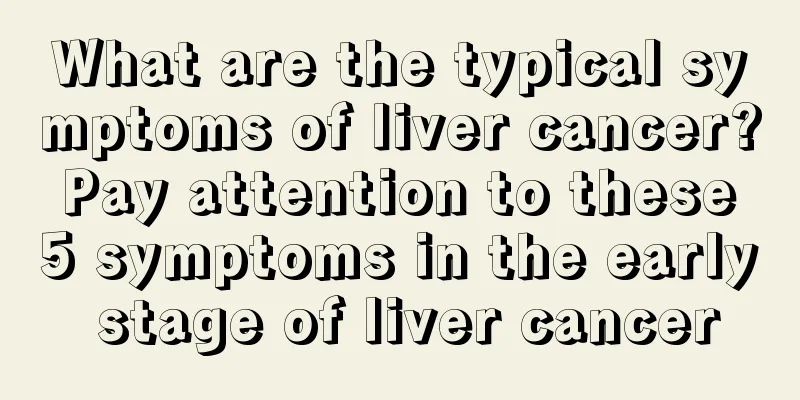What are the typical symptoms of liver cancer? Pay attention to these 5 symptoms in the early stage of liver cancer

|
Liver cancer is a common malignant tumor in my country. Its high incidence and high mortality rate rank third among cancers. People are afraid and solemn about the topic of liver cancer. No one wants to be related to it, but it seems to be hard to prevent. Is liver cancer really an "invisible killer" that is hard to prevent as people say? What are the typical symptoms of liver cancer? my country has a large number of liver cancer cases, which is inseparable from the large number of high-risk groups for liver cancer in my country. Specifically, there are six types of people with a high risk of liver cancer. First, hepatitis B patients or hepatitis B virus carriers for more than five years; second, people over 40 years old with a history of chronic hepatitis; third, patients with fatty liver and alcoholic liver; fourth, patients clinically diagnosed with cirrhosis; fifth, patients who currently have symptoms such as discomfort and pain in the liver area, and have tested abnormal alpha-fetoprotein but have not been confirmed to have liver cancer. 6. People with a family history of liver cancer. What are the typical symptoms of liver cancer? Since high-risk groups have a very high risk of liver cancer, it is recommended that people over 35 years old should undergo regular liver cancer screening every year. At the same time, you should always pay attention to whether you have any "abnormal signs". Generally speaking, the typical symptoms of liver cancer have the following stages: What are the typical symptoms of early liver cancer? From a medical clinical perspective, there are no clear symptoms in the early stages of liver cancer, which is why liver cancer is called the "silent killer." However, there are some common points among many patients that deserve our attention. 1. "Pseudo-gastric disease": such as nausea, fullness, and belching; 2. Dull pain and distending pain in the liver area; a hard mass can be felt in the right upper abdomen or the middle upper abdomen; 3. Bitter taste in the mouth, fever, sweating, bleeding from gums and nose, yellow sclera, and yellow urine; 4. Unexplained weight loss, emaciation, and fatigue; 5. Unexplained diarrhea, indigestion, etc. What are the typical symptoms of mid-to-late stage liver cancer? 1. Pain in the liver area and hepatomegaly Generally speaking, the painful area can be regarded as the location of the tumor, which is mostly persistent distending pain or dull pain. Liver pain is caused by the rapid growth of the tumor and the pulling of the liver capsule. If the lesion invades the diaphragm, the pain may involve the right shoulder. When the cancerous nodule ruptures, it may suddenly cause severe pain and symptoms and signs of peritonitis. If the amount of bleeding is large, it will cause syncope and shock. About 90% of patients have an enlarged liver, which is progressively enlarged, hard in texture, uneven, with nodules or lumps of varying sizes, blunt and irregular edges, and often with varying degrees of tenderness. 2. Signs of cirrhosis Patients with liver cancer and portal hypertension associated with cirrhosis may have symptoms such as splenomegaly, ascites, and venous collateral circulation. Increased bloody ascites is caused by cancer invading the liver capsule or rupturing into the abdominal cavity, and occasionally by peritoneal metastasis. 3. Paraneoplastic syndrome There are progressive weight loss, fever, loss of appetite, fatigue, malnutrition and cachexia, etc. A few patients with liver disease may have special systemic manifestations. Hypoglycemia and polycythemia are more common, and other rare ones include hypercalcemia, hyperlipidemia, carcinoid, etc. 4. Jaundice It mainly occurs in the late stage, either due to liver cell damage, or due to compression or invasion of the bile duct near the liver porta hepatis by the cancer mass, or due to bile duct obstruction caused by the detachment of cancer tissue and blood clots. 5. Symptoms of metastatic lesions In the late stage, metastatic lesions may occur, such as metastasis to the lungs, bones, and chest cavity. Chest cavity metastasis is more common on the right side, and there may be signs of pleural effusion. Bone or spinal metastasis may cause local tenderness or nerve compression symptoms, and intracranial metastatic cancer may have nerve localization signs. |
Recommend
What kind of care is provided before rectal cancer surgery?
Rectal cancer is a common malignant tumor in the ...
What are the effects and functions of okra
Although okra is called okra, it is not a food th...
What medicine is effective for rosacea?
People deal with various diseases in life. Many d...
What should I do if I have acne and peeling on my face?
Acne on the face is a phenomenon that no one want...
One week weight loss diet
Losing weight is a big need for many people, beca...
Is it better to dry your hair naturally or blow dry it
For women, because the hair is relatively long, i...
Treatment of surgical complications in patients with gastric cancer
The management of surgical complications in patie...
The easiest way to remove moles
It is a very common phenomenon for moles to grow ...
How to satisfy your husband after pregnancy?
Pregnancy is a long process for women, from the b...
What medicine is the best for removing dampness?
In real life, dampness in the body is a very comm...
How to adjust your biological clock
There are many common problems in life, and solvi...
What are the effects of fish glimpse
People should be familiar with fish in their dail...
What does ascorbic acid 1+ mean
Vitamins and blood are closely related. We often ...
The efficacy of Sophora japonica scrambled eggs and the people who are suitable to eat them
Sophora flowers are the flowers and stamens of th...
Which exercises are better for lymphoma
In addition to conventional treatments, there are...









